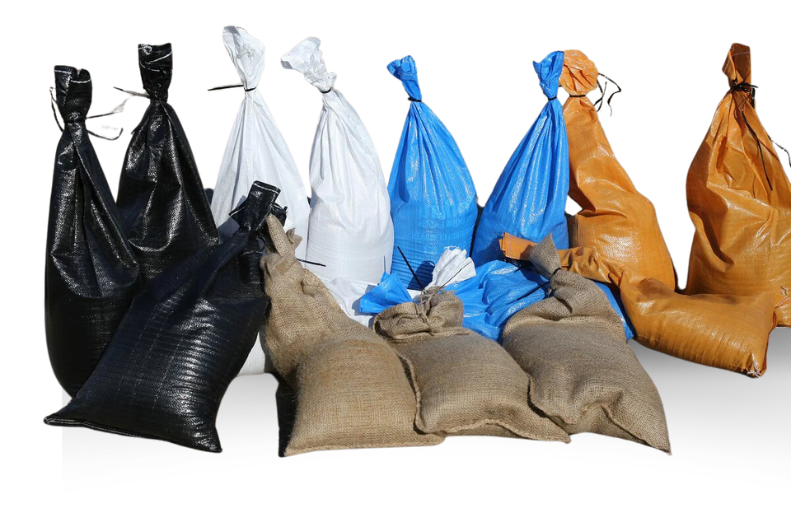Sandbags and burlap bags are two of the popular versatile packaging solutions.
While both serve practical purposes, they differ significantly in terms of material, functionality, and suitability for various tasks.
Here we’ll explore the characteristics of sandbags and burlap bags, their respective uses, and the factors to consider when choosing between them.
What are Sandbags
Material and Construction:
Sandbags are typically made from durable materials such as polypropylene, woven polyethylene, or burlap. They are designed to withstand heavy loads and harsh environmental conditions, making them ideal for construction projects, flood control, and erosion prevention.
Functionality:
Sandbags are primarily used for weight distribution and stabilization.
They are filled with sand or other granular materials to provide ballast and support for temporary structures, barriers, or flood defenses. The tightly woven fabric and double-sealed seams ensure that the contents remain secure and contained.
Applications:
Sandbags are commonly used in construction, landscaping, emergency preparedness, and military operations. They serve as a versatile solution for creating temporary structures, reinforcing levees, protecting property from flooding, and stabilizing equipment or machinery.
What are Burlap Bags?
Material and Construction:
Burlap bags, also known as hessian bags, are made from natural fibers derived from the jute plant. The coarse, woven texture of burlap provides strength and durability while allowing for breathability and moisture absorption.
Functionality:
Burlap bags are prized for their versatility and eco-friendly properties. They find their common use in the agricultural industry where they are utilized for packaging products such as coffee beans, grains, and potatoes. These bags are able to regulate moisture levels, thanks to the breathable nature of burlap. This way, they preserve the freshness and quality of the contents.
Applications:
Burlap bags find applications in agriculture, gardening, crafts, and decor. They are used for storing, transporting, and packaging a wide range of goods, including produce, seeds, nuts, and animal feed. Burlap bags are also popular for DIY projects, upholstery, and rustic-themed events or weddings.
Comparing Key Factors
Material:
Sandbags are typically made from synthetic materials like polypropylene or natural fibers like burlap. The choice of material depends on the intended use and environmental conditions.
Strength and Durability:
Sandbags are engineered to withstand heavy loads and harsh weather conditions. Burlap bags, while durable, may not offer the same level of strength and resistance as sandbags.
Breathability:
Burlap bags are breathable, allowing air to circulate and moisture to evaporate. This makes them suitable for storing agricultural products without risking spoilage. Sandbags, on the other hand, are designed to be impermeable to prevent sand or other fill material from leaking out.
Environmental Impact:
Burlap bags are biodegradable and compostable, making them a more sustainable option compared to synthetic sandbags. However, synthetic sandbags can be reused multiple times and are often recyclable.
Cost:
The cost of sandbags and burlap bags can vary depending on factors such as material, size, and quantity. Burlap bags may be more economical for certain applications, especially when purchased in bulk.
How to Choose Between Sandbags and Burlap Bags:
When deciding between sandbags and burlap bags, it’s essential to consider the specific requirements of the task at hand:
Consider Your Application:
If you require weight distribution, stabilization, or flood control, sandbags are the go-to choice. Their robust construction and ability to withstand harsh conditions make them indispensable for construction sites, flood prevention, and erosion control.
Burlap bags are an ideal option to store and transport agricultural products such as seeds and grains. As burlap is breathable, it facilitates airflow, thereby reducing the risk of spoilage.
Evaluate Material and Durability
Typically made from synthetic materials like polypropylene or woven polyethylene, sandbags are engineered for strength and durability.
These bags are ideal when it comes to handling heavy loads and harsh environmental conditions. Burlap bags also prove a more eco-friendly alternative as they are made from natural fibers obtained from the jute plant.
While not as durable as sandbags, burlap bags provide adequate strength for storing and transporting goods. Their coarse, woven texture provides a rustic charm while offering moderate durability.
Assess Environmental Impact
Synthetic sandbags can lead to plastic waste as they are not biodegradable. Therefore, they are required to be properly disposed of. Having said that, many synthetic sandbags can be reused and recycled.
Burlap bags are biodegradable and compostable, making them a more environmentally friendly choice. Their natural fibers decompose over time, reducing their impact on the environment.
Factor in Cost and Quantity
The cost of custom printed sandbags can vary depending on factors such as material, size, and quantity. While synthetic sandbags may be more expensive initially, their durability and reusability can offset long-term costs.
Burlap bags are generally more economical, especially when purchased in bulk. Their affordability makes them a practical choice for agricultural, storage, and DIY projects.
Prioritize Functionality and Aesthetics
Choose the option that best meets your functional needs, whether it’s weight distribution, breathability, or moisture absorption.
Consider the visual appeal of sandbags and burlap bags and how they complement the overall look and feel of your project or application.
Our Verdict:
Both sandbags and burlap bags serve essential functions across various industries and applications. While sandbags excel in heavy-duty tasks requiring weight distribution and stability, burlap bags shine in agricultural, storage, and eco-friendly contexts.
By understanding the differences between these two options and evaluating the specific requirements of each project, individuals and businesses can make informed decisions to meet their packaging and operational needs effectively.
Whether safeguarding property from flooding or preserving the freshness of agricultural goods, sandbags and burlap bags remain indispensable assets in the realm of packaging solutions.





